商学导论Chapter 8全部内容
- 格式:ppt
- 大小:1.99 MB
- 文档页数:40
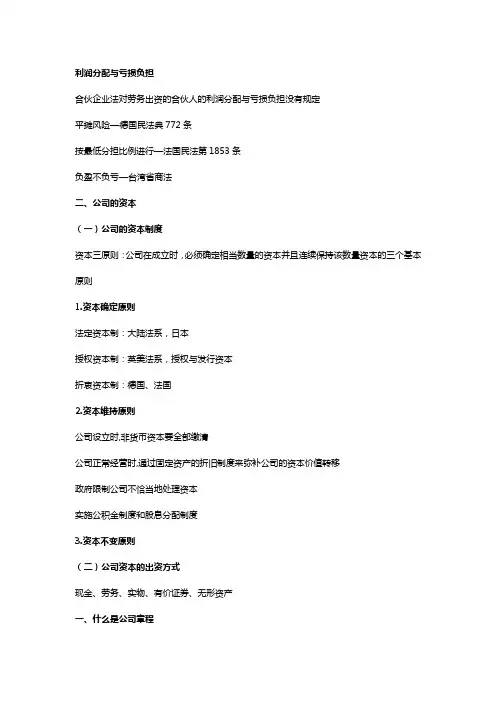
利润分配与亏损负担合伙企业法对劳务出资的合伙人的利润分配与亏损负担没有规定平摊风险—德国民法典772条按最低分担比例进行—法国民法第1853条负盈不负亏—台湾省商法二、公司的资本(一)公司的资本制度资本三原则:公司在成立时,必须确定相当数量的资本并且连续保持该数量资本的三个基本原则1.资本确定原则法定资本制:大陆法系,日本授权资本制:英美法系,授权与发行资本折衷资本制:德国、法国2.资本维持原则公司设立时,非货币资本要全部缴清公司正常经营时,通过固定资产的折旧制度来弥补公司的资本价值转移政府限制公司不恰当地处理资本实施公积金制度和股息分配制度3.资本不变原则(二)公司资本的出资方式现金、劳务、实物、有价证券、无形资产一、什么是公司章程规定公司的性质、地位、组织机构、权利能力、行为能力、责任能力以及公司对外关系的规范性文件,是公司的根本性大法。
公司章程含义:英美法系国家:美国:公司章程和公司细则;英国:公司大纲和公司细则。
公司章程或公司大纲是规范公司对外事务的;公司细则是规范公司对内事务的。
大陆法系国家:一个统一文件。
日本和德国规定公司章程必须经过公证。
绝对记载事项与相对记载事项:二、公司章程的作用设立公司的构件:资本、章程与发起人公司章程是公司设立的主要条件和重要文件公司章程是确立公司权利和义务关系的基本法律文件公司章程是确定公司经营管理人员的职责和权限范围法律文件三、公司章程的基本内容有限责任公司:(一)公司名称和住所;(二)公司经营范围;(三)公司注册资本;(四)股东的姓名或者名称;(五)股东的出资方式、出资额和出资时间;(六)公司的机构及其产生办法、职权、议事规则;(七)公司法定代表人;(八)股东会会议认为需要规定的其他事项。
股份有限公司:(一)公司名称和住所;(二)公司经营范围;(三)公司设立方式;(四)公司股份总数、每股金额和注册资本;(五)发起人的姓名或者名称、认购的股份数、出资方式和出资时间;(六)董事会的组成、职权和议事规则;(七)公司法定代表人;(八)监事会的组成、职权和议事规则;(九)公司利润分配办法;(十)公司的解散事由与清算办法;(十一)公司的通知和公告办法;(十二)股东大会会议认为需要规定的其他事项。
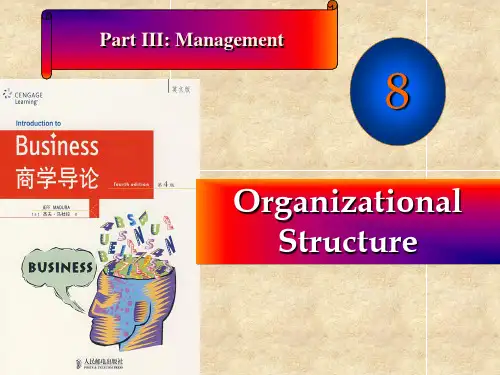
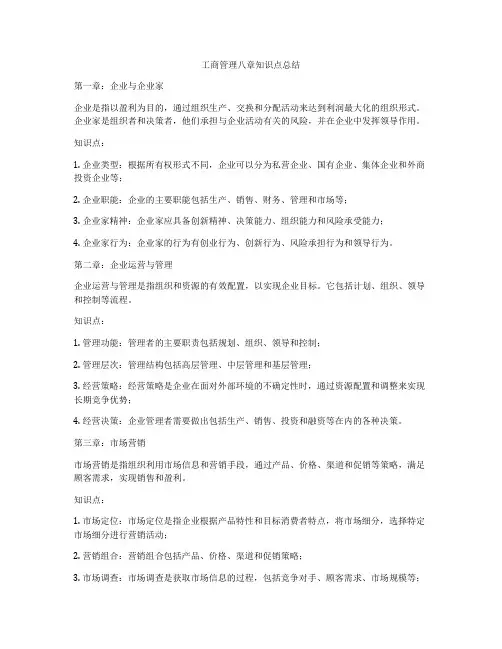
工商管理八章知识点总结第一章:企业与企业家企业是指以盈利为目的,通过组织生产、交换和分配活动来达到利润最大化的组织形式。
企业家是组织者和决策者,他们承担与企业活动有关的风险,并在企业中发挥领导作用。
知识点:1. 企业类型:根据所有权形式不同,企业可以分为私营企业、国有企业、集体企业和外商投资企业等;2. 企业职能:企业的主要职能包括生产、销售、财务、管理和市场等;3. 企业家精神:企业家应具备创新精神、决策能力、组织能力和风险承受能力;4. 企业家行为:企业家的行为有创业行为、创新行为、风险承担行为和领导行为。
第二章:企业运营与管理企业运营与管理是指组织和资源的有效配置,以实现企业目标。
它包括计划、组织、领导和控制等流程。
知识点:1. 管理功能:管理者的主要职责包括规划、组织、领导和控制;2. 管理层次:管理结构包括高层管理、中层管理和基层管理;3. 经营策略:经营策略是企业在面对外部环境的不确定性时,通过资源配置和调整来实现长期竞争优势;4. 经营决策:企业管理者需要做出包括生产、销售、投资和融资等在内的各种决策。
第三章:市场营销市场营销是指组织利用市场信息和营销手段,通过产品、价格、渠道和促销等策略,满足顾客需求,实现销售和盈利。
知识点:1. 市场定位:市场定位是指企业根据产品特性和目标消费者特点,将市场细分,选择特定市场细分进行营销活动;2. 营销组合:营销组合包括产品、价格、渠道和促销策略;3. 市场调查:市场调查是获取市场信息的过程,包括竞争对手、顾客需求、市场规模等;4. 客户关系管理:客户关系管理是指企业通过建立和维护与顾客之间的良好关系,以提高顾客满意度和忠诚度。
第四章:生产与运营管理生产与运营管理是指企业通过生产过程、供应链管理和质量控制等活动,实现产品和服务的生产和供应。
知识点:1. 生产过程管理:包括生产规划、生产控制、生产调度和生产成本控制等;2. 供应链管理:供应链管理是指企业与供货商、分销商和客户之间的协作关系,以满足客户需求;3. 质量管理:质量管理是指通过质量控制、质量改进和质量保证等活动,提高产品和服务的质量水平;4. 生产效率:企业在生产过程中需要关注生产效率,包括生产能力、生产成本和生产周期等指标。
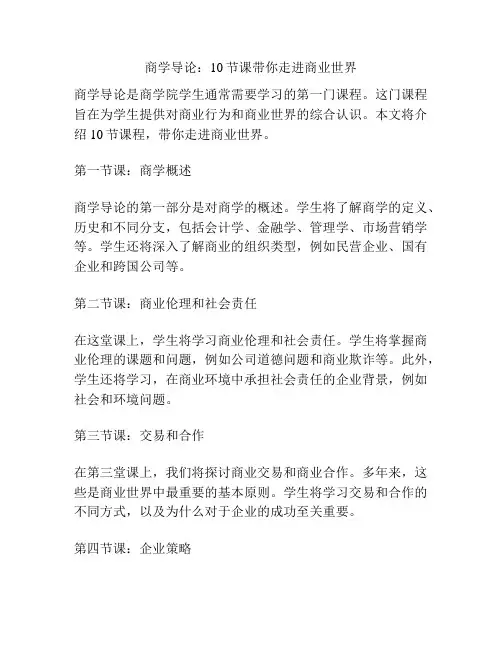
商学导论:10节课带你走进商业世界商学导论是商学院学生通常需要学习的第一门课程。
这门课程旨在为学生提供对商业行为和商业世界的综合认识。
本文将介绍10节课程,带你走进商业世界。
第一节课:商学概述商学导论的第一部分是对商学的概述。
学生将了解商学的定义、历史和不同分支,包括会计学、金融学、管理学、市场营销学等。
学生还将深入了解商业的组织类型,例如民营企业、国有企业和跨国公司等。
第二节课:商业伦理和社会责任在这堂课上,学生将学习商业伦理和社会责任。
学生将掌握商业伦理的课题和问题,例如公司道德问题和商业欺诈等。
此外,学生还将学习,在商业环境中承担社会责任的企业背景,例如社会和环境问题。
第三节课:交易和合作在第三堂课上,我们将探讨商业交易和商业合作。
多年来,这些是商业世界中最重要的基本原则。
学生将学习交易和合作的不同方式,以及为什么对于企业的成功至关重要。
第四节课:企业策略在这一课程中,学生将学习企业策略。
什么是企业策略?为什么它至关重要?学生将学习如何开发企业策略并了解如何实施它们。
此外,学生还将了解企业战略中的不同层次。
第五节课:营销管理在第五节课中,学生将学习营销管理。
他们将探讨市场营销的基础,例如市场和顾客分析,并学习如何开发和实施营销策略。
第六节课:管理实践在这一课程中,学生将学习实践性的管理技能。
他们将学习如何管理企业的财务、人力资源和物流,以及如何有效沟通和领导企业。
第七节课:金融原理在这一课程中,学生将学习金融原理,包括资本与金融市场、投资和风险管理。
学生将了解如何从财务角度看待企业,以及如何优化企业的财务状况。
第八节课:创业和创新在这一课程中,学生将学习创业和创新。
他们将了解如何开展商业创新,如何开拓市场并如何识别商业机会。
此外,学生还将学习如何成功创业。
第九节课:全球化和跨文化管理在全球化的今天,学生需要学习如何跨越文化和管理跨国公司。
在这堂课上,学生将学习全球化的挑战、跨越文化的传统陷阱以及如何应对跨国企业的管理问题。
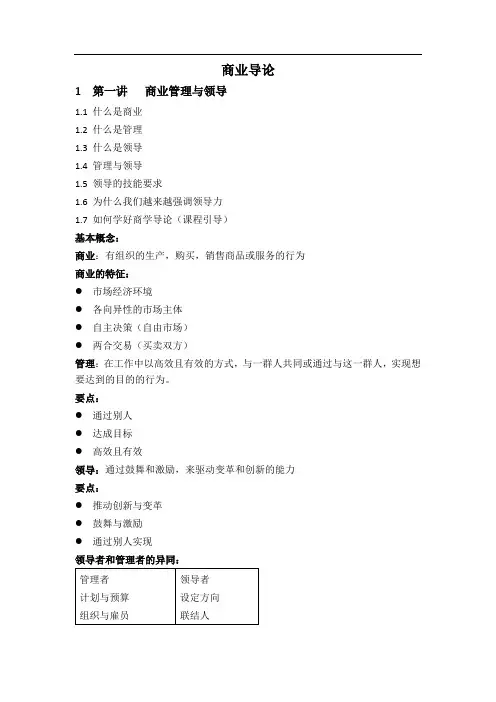

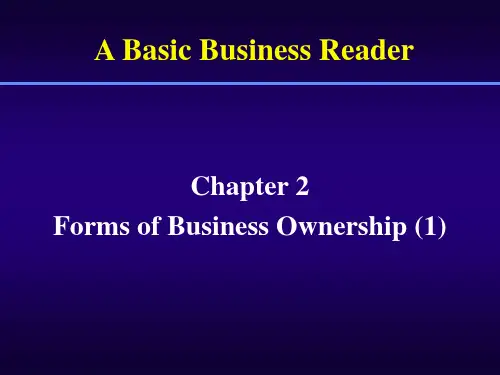
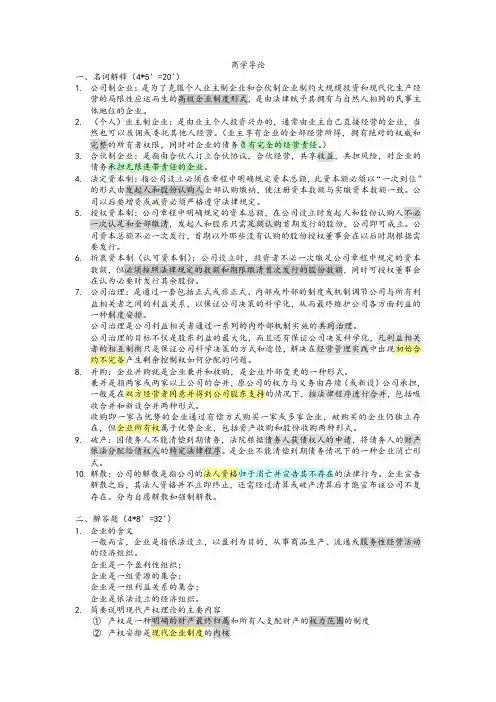
商学导论一、名词解释(4*5’=20’)1.公司制企业:是为了克服个人业主制企业和合伙制企业制约大规模投资和现代化生产经营的局限性应运而生的高级企业制度形式,是由法律赋予其拥有与自然人相同的民事主体地位的企业。
2.(个人)业主制企业:是由业主个人投资兴办的,通常由业主自己直接经营的企业,当然也可以雇佣或委托其他人经营。
(业主享有企业的全部经营所得,拥有绝对的权威和完整的所有者权限,同时对企业的债务负有完全的经营责任。
)3.合伙制企业:是指由合伙人订立合伙协议,合伙经营,共享收益,共担风险,对企业的债务承担无限连带责任的企业。
4.法定资本制:指公司设立必须在章程中明确规定资本总额,此资本额必须以“一次到位”的形式由发起人和股份认购人全部认购缴纳,使注册资本数额与实缴资本数额一致。
公司以后要增资或减资必须严格遵守法律规定。
5.授权资本制:公司章程中明确规定的资本总额,在公司设立时发起人和股份认购人不必一次认足和全部缴清,发起人和股东只需足额认购首期发行的股份,公司即可成立。
公司资本总额不必一次发行,首期以外那些没有认购的股份授权董事会在以后时期根据需要发行。
6.折衷资本制(认可资本制):公司设立时,投资者不必一次缴足公司章程中规定的资本数额,但必须按照法律规定的数额和期限缴清首次发行的股份数额,同时可授权董事会在认为必要时发行其余股份。
7.公司治理:是通过一套包括正式或非正式、内部或外部的制度或机制调节公司与所有利益相关者之间的利益关系,以保证公司决策的科学化,从而最终维护公司各方面利益的一种制度安排。
公司治理是公司利益相关者通过一系列的内外部机制实施的共同治理。
公司治理的目标不仅是股东利益的最大化,而且还有保证公司决策科学化,凡利益相关者的相互制衡只是保证公司科学决策的方式和途径,解决在经营管理实践中出现初始合约不完备产生剩余控制权如何分配的问题。
8.并购:企业并购就是企业兼并和收购,是企业外部变更的一种形式。
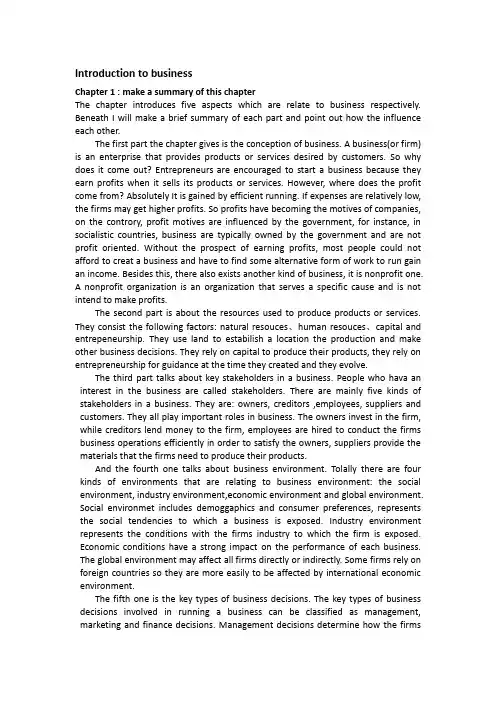
Introduction to businessChapter 1 : make a summary of this chapterThe chapter introduces five aspects which are relate to business respectively. Beneath I will make a brief summary of each part and point out how the influence each other.The first part the chapter gives is the conception of business. A business(or firm) is an enterprise that provides products or services desired by customers. So why does it come out? Entrepreneurs are encouraged to start a business because they earn profits when it sells its products or services. However, where does the profit come from? Absolutely It is gained by efficient running. If expenses are relatively low, the firms may get higher profits. So profits have becoming the motives of companies, on the controry, profit motives are influenced by the government, for instance, in socialistic countries, business are typically owned by the government and are not profit oriented. Without the prospect of earning profits, most people could not afford to creat a business and have to find some alternative form of work to run gain an income. Besides this, there also exists another kind of business, it is nonprofit one.A nonprofit organization is an organization that serves a specific cause and is not intend to make profits.The second part is about the resources used to produce products or services. They consist the following factors: natural resouces、human resouces、capital and entrepeneurship. They use land to estabilish a location the production and make other business decisions. They rely on capital to produce their products, they rely on entrepreneurship for guidance at the time they created and they evolve.The third part talks about key stakeholders in a business. People who hava an interest in the business are called stakeholders. There are mainly five kinds of stakeholders in a business. They are: owners, creditors ,employees, suppliers and customers. They all play important roles in business. The owners invest in the firm, while creditors lend money to the firm, employees are hired to conduct the firms business operations efficiently in order to satisfy the owners, suppliers provide the materials that the firms need to produce their products.And the fourth one talks about business environment. Tolally there are four kinds of environments that are relating to business environment: the social environment, industry environment,economic environment and global environment. Social environmet includes demoggaphics and consumer preferences, represents the social tendencies to which a business is exposed. Industry environment represents the conditions with the firms industry to which the firm is exposed. Economic conditions have a strong impact on the performance of each business. The global environment may affect all firms directly or indirectly. Some firms rely on foreign countries so they are more easily to be affected by international economic environment.The fifth one is the key types of business decisions. The key types of business decisions involved in running a business can be classified as management, marketing and finance decisions. Management decisions determine how the firmsresources are alloted, maketing decisions determine the product to be sold, along with the pricing, distribution, and promotion of that product. Finance decisions determine how the firm obtains and invests funds. Business decisions are improved as a result of accounting and information systems.accounting is used to monitor performance and detect inefficient uses of resouces in order to improve business decisions.All the five aspects above mentioned form the basic conception of business, only if we know the defines of each term can we understand business well. Chapter 2 How do business and social responsibility embody in business? Answer:when talking about business ethics and social responsibility, firms have many responsibilities to employees, stockholders, creditors, the environment and the community. Their decisions regarding the ethics and social responsibility can enhance its business performance.On the one hand, let us talk about the necessities of such kinds of responsibilities. Firms can gain the trust of customers, the direct or potential buyers e can increase their revenues, the only way to get profit. Why not? The firms can gain trust of employees, they serve the companies and customers well is the most important fortune. Through this, firms can increase effort by employees; firms can gain the trust of investors, which allows the firm to more easily obtain additional funding from investors; firms can gain the trust of creditors, which allows firm to more easily obtain additional funding from creditors; firms can gain the trust of stakeholders that the firm is not harming the environment; firms can gain the continued support of customers who may buy products in the future. All in all, the precondition is that firms shoud be responsible to all the above mentioned groups.On the other hand, how to embody firms have done something which is responsible for the customers,employees,stockholders,creditors,environment and communities.Firms have a responsibility to produce safe products and to sell their products without misleading the customers, they should be honest about products sold.Firms can satisfy their responsibility toward employees by enforcing safty guidelines, offering procedure that allows employees to report any complaints Firms should create incentives for managers to ensure that their decisions are intended to maximize the stock prize.Firms should manage the business well so that creditors can paid on time.Firms have a responsibilily to maintain a clean environment when operating their business.Firms should demonstrate a commitment to the community where the customers live.All of the firms decisions like those can bring a good reflection and can enhance their performance. Thus, business ethics and social responsibility affect firms businiss.Chapter 3 What are the factors that influence market price?Answer: Before answering this question, we should make sure what market price is. We all know that the performance of firms is affected by changes in the prices theycharge for products and the prices they pay for supplies are influenced by demand and supply conditions. When the quatity supplied by firms is less than the quatity demanded by customers, the market price goes higher,vice versa. So the market price may be influenced by the flexible markets demands and supplies. Thus far, the specific factors that influence the market price are the consumer income, consumer prefrences , production expenses. Consumers income determine the amount of products and services that individules can purchase. Higher consumer income generally results in a higher demand for products. As consumer preferences for a particular product change, the quantity of that product demanded by consumers may change. And the third one that can affect equilibrium prices is a change in productiion expenses. When firms experience lower expenses, they are willing to supply more at any given price. Thus, these are the three factors that influence markt price.。


商学精要8版
《商学精要》第8版是一本教材,适合用作经管专业学生企业概论、商学导论等课程的教材,也适合作为企业管理人员的培训用书,还可供对企业管理感兴趣的读者阅读参考。
该书从分析当代商务环境入手,全面系统地介绍了企业的各项商务活动及管理原理,内容丰富,涵盖企业的各个职能领域,包括管理、组织、运营、人力资源管理、营销管理、信息管理、会计与财务等。
聚焦最基本的企业管理原理和管理活动,简明实用,深入浅出。
以上信息仅供参考,可以阅读原书了解更多内容。